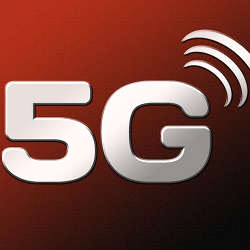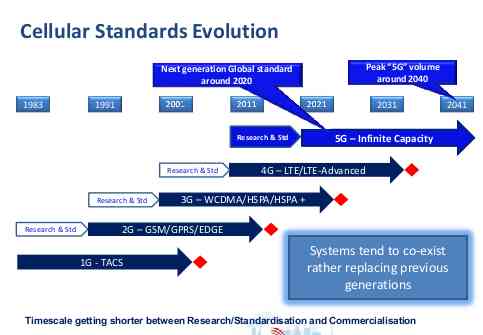
Some say fifth-generation (5G) mobile networks will enable the Internet of Things, so your car might pay your parking meter before time runs out. Others suggest 5G will turn the current generation of health monitors for smartphones, such as the Samsung Galaxy S5‘s built-in heart rate monitor and devices like Zensorium’s Tinké, into nodes in your own personal healthcare cloud. Neelie Kroes, vice president of the European Commission, even sees them as a solution to youth unemployment.
For a technology that doesn’t even exist yet, 5G networks are certainly generating a lot of traffic.
One point nearly everyone agrees on, however, is that 5G networks will be up and running by the year 2020. China has announced plans to test a 5G network by then, and the International Telecommunication Union has a 5G-oriented program for “International Mobile Telecommunications for 2020 and beyond.” South Korea announced in January it was investing $1.5 billion to roll out 5G service within 6 years (though it hopes to have a demonstration network up and running by the time it hosts the 2018 Winter Olympics).
This timetable is in line with the development of previous mobile technology generations. “Every new generation happens roughly every 10 years,” says Farooq Khan, president of Dallas, TX-based Samsung R&D America. He notes that analog cellular technology debuted in the 1980s, with the digital second generation (2G) coming on in the 1990s, and 3G making its debut in the “aughts.” “4G was deployed in 2010, and at that point, we started thinking about 5G technology,” Khan says, explaining, “we need to prepare this technology internally for many years before any standards effort starts. It takes three to five years to develop the standard, and then another 18 months to two years before you see any deployment.”
The need for a more capable network is apparent. According to the Cisco Visual Networking Index Global Mobile Data Traffic Forecast for 2013 to 2018, worldwide mobile data traffic will increase more than 10-fold over the next four years, with more than 90% of it coming from smartphones, laptops, and tablets. “More and more people are using smartphones, as well as applications that require higher and higher bandwidth, like YouTube and video streaming. That has been the primary source of increasing data demand,” says Khan. Continuing to evolve existing technology can provide “incremental changes,” in Khan’s words, but not nearly enough to meet demand.
The technological approach to 5G networks, as with previous generations, will involve fitting more traffic into the same portion of the spectrum. The initial analog generation of mobile devices, explains Philip Solis, research director at Oyster Bay, NY-based technology market intelligence firm ABI Research, divided the available radio spectrum by frequency. “Each person that made a call had a whole pair of frequencies,” explains Solis. In 2G networks, each frequency pair was divided by time as well, interleaving multiple calls in the same band. The advent of 3G networks added code division, a way of “tagging” messages so each frequency-plus-time slice could carry more than one message, while 4G networks added manipulation of the signal amplitude (and dropped code division).
Wireless carriers have often muddied these distinctions, because connection speeds can overlap from one generation to the next, Solis says; if one carrier’s 3G network is faster than a competitor’s 4G network, the temptation is strong for the first carrier to label theirs ‘4G’ as well.
The next generation of networks will add spatial division, likely accomplished in two ways: cells will be smaller, and transmissions will be more tightly focused. “Spatial division is something you can do with network topology,” explains Solis. “Let’s say you have one cell, and 10 people can be doing data full speed at the same time. If you split that one cell up into four cells, you have four times the capacity you used to have.”
Smaller cells are also needed to accommodate higher frequencies, another anticipated feature of 5G. “Current radio communications generally happens at frequencies up to 3 GHz,” says Khan. “That’s considered to be ‘beachfront property’—prime spectrum—because propagation conditions are favorable. But we’ve started looking at much higher frequencies—millimeter-wave frequencies 30 GHz and above, which can give you higher data rates. Due to some propagation challenges at high frequencies, you can’t have very large cells.”
That’s why 5G networks will probably combine smaller cells with more precisely targeted transmissions. “What 5G does is, within each cell, it can divide space by using 3D beamforming,” says Solis. “Instead of just broadcasting in all directions or by sector, now you’re kind of aiming the beam at different users at the same time.” This MIMO (multi-in multi-out) approach further enables more messages to occupy the same spectrum space.
Vendors like Samsung and Huawei are already hard at work, both helping to define 5G and preparing devices for it. “Internally, we have a vision of what this technology will look like,” says Samsung’s Khan. “We have a high level of confidence in this millimeter-wave technology, and we plan to bring it to the standards body in the next year or two.”
Other working groups, like the European Union project Mobile and Wireless Communications Enablers for the Twenty-Twenty Information Society, and research institutions worldwide, are similarly working on their own approaches. All are working from a similar set of assumptions, despite the absence of a standard: for example, Samsung can confidently work on smaller antenna arrays its handsets will need to receive high-frequency 5G signals.
Once 5G networks are deployed, they will be able to handle not only the increasing demands of smartphones and tablets, but also all of the communications of the sensors required for the Internet of Things and wearable technologies. Those sensors may not be transmitting as much data as a YouTube video, but “if the average number of devices per person goes from 1.2 or 1.5 all the way up to 10 to 20 devices per person, you’re going to have a lot of pings to the network,” says Solis. “5G is going to help with that.”
Logan Kugler is a freelance technology writer based in Clearwater, FL. He has written for over 60 major publications.




Join the Discussion (0)
Become a Member or Sign In to Post a Comment